Software pioneer and philanthropist Dame Stephanie Shirley
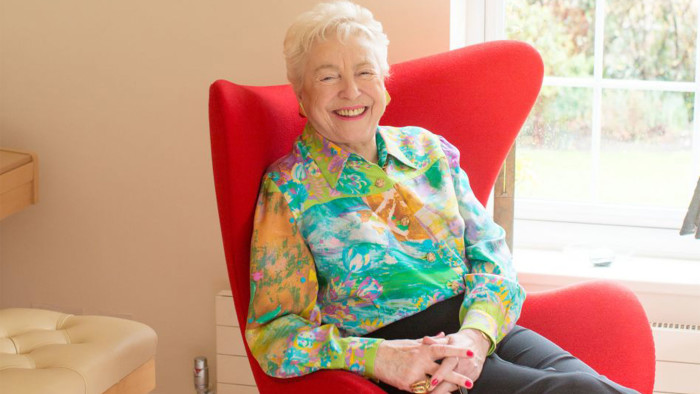
Simply sign up to the Life & Arts myFT Digest -- delivered directly to your inbox.
Dame Stephanie Shirley’s two-level apartment in Henley-on-Thames is a sanctuary of calm and order. Flawless cream carpets stretch from off-white wall to off-white wall. Peaceful artworks, most of them abstract, punctuate the clutter-free space.
Shirley hasn’t always inhabited such a serene environment. Her story is one of meeting adversities head-on, and turning them into opportunities. She arrived in Britain as a five-year-old Jewish refugee from Nazi-occupied Europe, clutching nothing but a teddy bear and her elder sister’s hand. She retired a multimillionaire at the helm of an 8,500-strong IT empire of her own making, and since then she has set about ridding herself of her fortune: to date she has donated £67m and is revelling in the good work it is doing.
Shirley, dressed in simple black trousers and an exuberantly patterned silk shirt, leads me into her spacious office. “I spend more than half of my waking life in here,” she says. Now 81 and “nominally retired for more than 20 years”, she shows little sign of slowing down. She shares the duplex apartment with her husband, Derek. The couple met while working at the Post Office Research Station at Dollis Hill in London, and when they married in 1959, Shirley did what was expected of women working in the same organisation as their husbands: she retired.
However, her next move was much less predictable. In 1962, there were few computers in the country and no software industry to speak of. Armed with her experience of the Post Office’s pioneering computer systems and a masters degree in the new subject, Shirley launched her own business creating and selling software. Looking back, she describes it as “a crusade for women to be respected for their capabilities and to be able to work in a family-friendly way”. Almost all her early employees were women, and many, like her, worked flexible hours, spending time at home with young children.
Favourite thing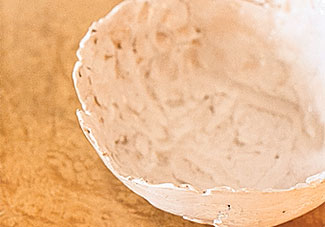
Given pride of place by the front door is a roughly constructed bowl with an opalescent glaze. “Isn’t that glorious,” beams Shirley, explaining that it was made by autistic children at the school she founded in 1999. “Art is a route of communication for them,” she says. Prior’s Court school in Berkshire is the philanthropic project Shirley is most proud of, and also the most expensive, having cost £30m. “Some people thought it was too extravagant — it has a kiln, a huge art collection, gardens, a pond, a wild wood. But we’re getting good results.”
Shirley fought entrenched sexism (her now well-known nickname, “Steve”, helped her win several early contracts in a male-dominated world), ever-increasing competition in the IT sector, and several recessions. At its peak in 2000, the business that she had started from her dining-room table with an investment of just £6 was worth almost £2.6bn. Shirley received an OBE in 1980 and was made a dame in 2000.
The desk she sits at today is a far cry from the humble surface where her entrepreneurial career began. Designed by Nick Allen, the piece is composed of twin plate-glass oblongs supported by an intricate treelike bronze base, and it fills half of the room. Allen’s work can be found elsewhere in the house, and most of it has been custom-designed.
Adjoining the office is a small upstairs lounge where several John Piper paintings hang on the wall. Among them is a small abstracted landscape, the first painting Shirley bought, and she remembers the shock of finding herself able to afford such a thing. From the window it is possible to glimpse the stretch of the river Thames that hosts Henley’s annual regatta. On most days, Shirley and her husband stroll on the riverbank. On the windowsill stands the sensual form of a pot by Lucy Rie: another refugee from Nazi Austria who flourished in her adoptive country. “You can just feel her hands have been there,” says Shirley.
She is also keen to show me her bathrooms. One contains a vast freestanding oval bathtub and a shelf stacked with ceramics and small sculptures. A monumental washbasin, hewn from limestone and decorated with gold leaf, dominates the other. Shirley cites Kettle’s Yard in Cambridge, the former home of Jim Ede, as her inspiration. “It gave me the idea that even a bathroom should be very beautiful,” she says. “It’s really rather fun showing the house off,” she adds as she disappears down the steep, narrow staircase.
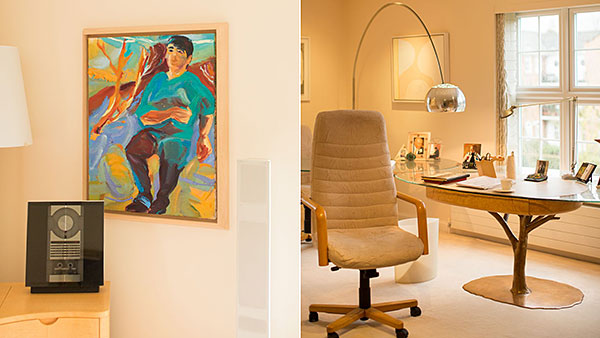
Housework is not on the agenda for self-professed “workaholic” Shirley, who declares the kitchen “not my empire”. The couple’s housekeeper, Kay, takes charge of domestic duties. Shirley prefers to spend any spare time reading in a crimson armchair in the living room next door. “It is quite difficult when you become wealthy not to change and start worrying about new yachts and things like that. So we’ve basically kept to our same middle-class standard of living, but I have been a bit extravagant with some of my artwork.” She points out a jug by Pablo Picasso, a small Henry Moore bronze sculpture, a Barbara Hepworth stone carving and two “quite wild” paintings by Alfred Wallis.
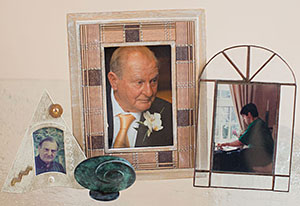
Yet the artwork that most stands out in this room is a large, vivid portrait of Shirley’s son, Giles. It was painted by June Redfern in 1998, a few months before a seizure killed him in his sleep, aged 35. Shirley explains how Redfern has “somehow caught his essence: a big powerful lad, with no mouth because he had no speech.” Giles was profoundly autistic, and caring for her beloved, unpredictable son became a major part of her life. The struggle to balance the high level of support Giles needed with the demands of her growing business took its toll, and in her memoir Let IT Go, Shirley describes the recurrent allure of suicide and the devastating nervous breakdown she suffered in 1976.
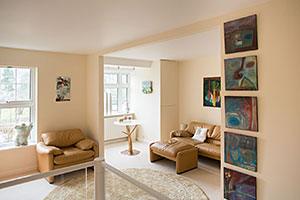
Over the years, Shirley has given a great deal of money to other causes, including the founding of the Oxford Internet Institute in 2001, but autism is the main focus of her philanthropy. As ever, Shirley is ambitious. “Unless you have that big aim, you find yourself just fiddling around.” She has set up several charities, founded a school and instigated research into this enigmatic but increasingly diagnosed condition. Her main focus today is setting up a high-level think-tank to create a UK national strategy for autism by 2017.

A clock chimes loudly in the corridor outside. The clock and a large wooden cabinet, inherited from Shirley’s Dutch grandmother, are the only antiques on show. They are also the only obvious reminders of her early years. Her biological parents don’t figure. Although they both survived the war, their marriage did not. Her father returned to Germany and fell out of touch. Her mother settled in England, but the relationship between mother and younger daughter was always strained.
The 250-year-old grandfather clock belonged to the foster parents who took in the bewildered little girl who stumbled off a Kindertransport train in 1939. Their kindness and the constant memory of how lucky she is to have survived at all are forces that motivate her. “Because I was a refugee, so many people helped me, so I became a philanthropist. Because I was a refugee, I learnt to welcome change, otherwise I wouldn’t have survived.”
Some 75 years on, Shirley is at peace with her life. “I can’t bring my son back. My marriage is still intact. My life is now very rich. I’ve got dreams to work on, things to implement. But I’ve done what I had it in me to do.”
Photographs: Rick Pushinsky
Comments